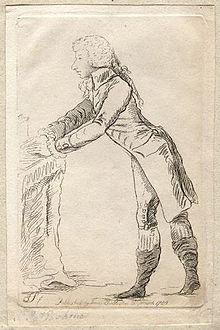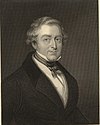| The Right HonourableThe Earl of RosslynGCB PC | |
|---|---|
 | |
| Lord Keeper of the Privy Seal | |
| In office 10 June 1829 – 15 November 1830 | |
| Monarchs | |
| Prime Minister | The Duke of Wellington |
| Preceded by | The Earl of Ellenborough |
| Succeeded by | The Earl of Durham |
| Lord President of the Council | |
| In office 15 December 1834 – 8 April 1835 | |
| Monarch | William IV |
| Prime Minister | Sir Robert Peel, Bt |
| Preceded by | The Marquess of Lansdowne |
| Succeeded by | The Marquess of Lansdowne |
| Member of the House of Lords Lord Temporal | |
| In office 2 January 1805 – 18 January 1837 Hereditary Peerage | |
| Preceded by | The 1st Earl of Rosslyn |
| Succeeded by | The 3rd Earl of Rosslyn |
| Personal details | |
| Born | (1762-02-06)6 February 1762 |
| Died | 18 January 1837(1837-01-18) (aged 74) |
| Nationality | British |
| Political party | |
| Spouse |
Harriet Bouverie
(m. 1790; died 1810) |
| Children | James St Clair-Erskine, 3rd Earl of Rosslyn |
| Parent(s) | Sir Henry Erskine, 5th Baronet Janet Wedderburn |
| Relatives | Alexander Wedderburn, 1st Earl of Rosslyn (uncle) |
General James St Clair-Erskine, 2nd Earl of Rosslyn, GCB, PC (6 February 1762 – 18 January 1837) was a Scottish military officer, politician and peer who served as Lord President of the Council from 1834 to 1835.
Background and education

Erskine was the son of Lieutenant-General Sir Henry Erskine, 5th Baronet, and Janet, daughter of Peter Wedderburn (a Lord of Session under the judicial title of Lord Chesterhall) and sister of Alexander Wedderburn, 1st Earl of Rosslyn. Lord Rosslyn's earldom had been created with special remainder to his nephew, Erskine. Erskine succeeded as sixth baronet in 1765, at the age of three, on the death of his father. He was educated at Edinburgh High School and Eton, and was commissioned in the 21st Light Dragoons in 1778.
Military career
Erskine was assistant Adjutant-General in Ireland in 1782. In 1793, he became Adjutant-General, in which capacity he served at the Siege of Toulon and Corsica. In 1795, he was promoted to colonel and appointed Aide-de-Camp to King George III. He became a major-general in 1798, lieutenant-general in 1805, and general in 1814. In 1806, he was a member of the special mission to Lisbon, which resulted in Sir Arthur Wellesley (later the Duke of Wellington) being sent to the Peninsular. He also saw action in Denmark
As a result of the Slave Compensation Act 1837, Erskine received a £3,626 payment from the British government, as he was a trustee for the Lower Walrond and Upper Walrond slave plantations in Antigua owned by his son-in-law Bethell Walrond.
Political career
Erskine was a member of the House of Commons for the English pocket boroughs of Castle Rising between 1782 and 1784 and Morpeth between 1784 and 1796. Initially a Whig, an adherent of Edmund Burke and an active supporter of Charles James Fox against William Pitt the Younger in the debates over the East India Company, he was one of the managers of the Impeachment of Warren Hastings. In 1789, on inheriting the Rosslyn and Dysart estates from his cousin James Paterson St Clair, he adopted the name St Clair before his own surname. In 1796, he was elected for the Dysart Burghs in Fife, a constituency traditionally under the St Clair influence.
In January 1805, he succeeded his uncle as Earl of Rosslyn, being by this time considered a Tory, and, after the end of the Napoleonic Wars, continued his political career in the House of Lords. He was a member of the cabinet as Lord Privy Seal from 1829 to 1830 under the Duke of Wellington's and Lord President of the Council under Sir Robert Peel from 1834 to 1835. In 1829, he was sworn of the Privy Council.
Family
Lord Rosslyn married Harriet Elizabeth, daughter of the Hon. Edward Bouverie, in 1790. She died in August 1810. Rosslyn remained a widower until his death in January 1837, aged 74. He was succeeded by his son, James.
References
- Von Pivka, Otto; Roffe, Michael (2013). The King's German Legion. Osprey Publishing. p. 8. ISBN 978-1-4728-0169-2.
- "James St Clair-Erskine, 2nd Earl of Rosslyn". University College London. Retrieved on 15 September 2021.
- "leighrayment.com House of Commons: Carmarthen East and Dinefwr to Chesterton". Archived from the original on 29 August 2018. Retrieved 5 October 2009.
- "leighrayment.com House of Commons: Mitcham to Motherwell South". Archived from the original on 10 August 2009. Retrieved 5 October 2009.
- "leighrayment.com House of Commons: Dumbarton to Dysart Burghs". Archived from the original on 7 April 2017. Retrieved 5 October 2009.
- ^ "No. 18584". The London Gazette. 12 June 1829. p. 1085.
- "No. 19221". The London Gazette. 16 December 1834. p. 2266.
- Military service
- Robert Beatson, A Chronological Register of Both Houses of Parliament (London: Longman, Hurst, Res & Orme, 1807)
- Concise Dictionary of National Biography (1930)
- Lewis Namier & John Brooke, The History of Parliament: The House of Commons 1754-1790 (London: HMSO, 1964)
External links
- Hansard 1803–2005: contributions in Parliament by the Earl of Rosslyn
- "Archival material relating to James St Clair-Erskine, 2nd Earl of Rosslyn". UK National Archives.

- Chisholm, Hugh, ed. (1911). "Rosslyn, Earls of" . Encyclopædia Britannica. Vol. 23 (11th ed.). Cambridge University Press. pp. 752–753.
- 1762 births
- 1837 deaths
- Nobility from Midlothian
- People educated at the Royal High School, Edinburgh
- Lord Presidents of the Council
- Lords Privy Seal
- Members of the Privy Council of the United Kingdom
- Members of the Parliament of Great Britain for Scottish constituencies
- Members of the Parliament of Great Britain for English constituencies
- British MPs 1780–1784
- British MPs 1784–1790
- British MPs 1790–1796
- British MPs 1796–1800
- Clan Erskine
- Members of the Parliament of the United Kingdom for Scottish constituencies
- Members of the Parliament of the United Kingdom for Fife constituencies
- UK MPs 1801–1802
- UK MPs 1802–1806
- UK MPs who inherited peerages
- British Army generals
- Conservative Party (UK) hereditary peers
- Earls in the Peerage of the United Kingdom
- Knights Grand Cross of the Order of the Bath
- Lord-lieutenants of Fife
- British Army personnel of the Napoleonic Wars
- British Army personnel of the French Revolutionary Wars
- 14th King's Hussars officers
- 8th King's Royal Irish Hussars officers
- 12th Royal Lancers officers
- Ambassadors of the United Kingdom to Portugal
- Recipients of payments from the Slavery Abolition Act 1833
- People educated at Eton College
